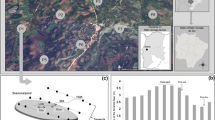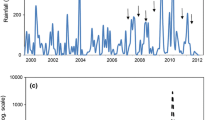Abstract
Recurring drying and wetting events are likely to increase in frequency and intensity in predicted future droughts in the central USA and alter the regeneration potential of species. We explored the resistance of seed banks to successive droughts in 53 sites across the nine locations in baldcypress swamps in the southeastern USA. Along the Mississippi River Alluvial Valley and northern Gulf of Mexico, we investigated the capacity of seed banks to retain viable seeds after successive periods of drying and wetting in a greenhouse study. Mean differences in species richness and seed density were compared to examine the interactions of successive droughts, geographical location and water regime. The results showed that both species richness and total density of germinating seedlings decreased over repeated drought trials. These responses were more pronounced in geographical areas with higher annual mean temperature. In seed banks across the southeastern swamp region, most species were exhausted after Trial 2 or 3, except for semiaquatic species in Illinois and Tennessee, and aquatic species in Texas. Distinct geographical trends in seed bank resistance to drought demonstrate that climate-induced drying of baldcypress swamps could influence the regeneration of species differently across their ranges. Despite the health of adult individuals, lack of regeneration may push ecosystems into a relict status. Seed bank depletion by germination without replenishment may be a major conservation threat in a future with recurring droughts far less severe than megadrought. Nevertheless, the protection of moist refugia might aid conservation.




Similar content being viewed by others
References
Baskin CC, Baskin JM. 2014. Seeds: ecology, biogeography, and evolution of dormancy and germination. Amsterdam: Elsevier.
Bond NR, Lake PS, Arthington AH. 2008. The impacts of drought on freshwater ecosystems: an Australian perspective. Hydrobiologia 600:3–16.
Brock MA. 2011. Persistence of seed banks in Australian temporary wetlands. Freshw Biol 56:1312–27.
Brock MA, Rogers KH. 1998. The regeneration potential of the seed bank of an ephemeral floodplain in South Africa. Aquat Bot 61:123–35.
Cayan DR, Das T, Pierce DW, Barnett TP, Tyree M, Gershunov A. 2010. Future dryness in the southwest US and the hydrology of the early 21st century drought. Proc Natl Acad Sci 107:21271–6.
Chen I-C, Hill JK, Ohlemüller R, Roy DB, Thomas CD. 2011. Rapid range shifts of species associated with high levels of climate warming. Science 333:1024–6.
Coats S, Smerdon JE, Cook BI, Seager R. 2014. Are simulated megadroughts in the North American Southwest forced? J Clim 28:124–42.
Cook BI, Ault TR, Smerdon JE. 2015. Unprecedented 21st century drought risk in the American Southwest and Central Plains. Sci Adv 1:e1400082.
Cook ER, Seager R, Cane MA, Stahle DW. 2007. North American drought: reconstructions, causes, and consequences. Earth Sci Rev 81:93–134.
Giuliani AL, Kelly EF, Knapp AK. 2014. Geographic variation in growth and phenology of two dominant central US grasses: consequences for climate change. J Plant Ecol 7:211–21.
IPCC. 2014. Summary for Policymakers. Field CB, Barros VR, Dokken DJ, Mach KJ, Mastrandrea MD, Bilir TE, Chatterjee M, Ebi KL, Estrada YO, Genova RC, Girma B, Kissel ES, Levy AN, MacCracken S, Mastrandrea PR, White LL, Eds. Climate change 2014: impacts, adaptation, and vulnerability. part A: global and sectoral aspects. Contribution of working group II to the fifth assessment report of the intergovernmental panel on climate change. Cambridge, and New York, NY: Cambridge University Press, p 1–32.
Lake PS. 2003. Ecological effects of perturbation by drought in flowing waters. Freshw Biol 48:1161–72.
Lake PS. 2011. Drought and aquatic ecosystems: effects and responses. Hoboken: Wiley.
Lehman A. 2005. JMP for basic univariate and multivariate statistics: a step-by-step guide. Cary: SAS Institute.
Mallakpour I, Villarini G. 2015. The changing nature of flooding across the central United States. Nat Clim Change 5:250–4.
Maza-Villalobos S, Poorter L, Martinez-Ramos M. 2013. Effects of ENSO and temporal rainfall variation on the dynamics of successional communities in old-field succession of a tropical dry forest. Plos ONE 8(12):e82040.
Middleton B. 1999. Wetland restoration, flood pulsing, and disturbance dynamics. Hoboken: Wiley.
Middleton B. 2009. Regeneration potential of Taxodium distichum swamps and climate change. Plant Ecol 202:257–74.
Middleton BA. 2016. Effects of salinity and flooding on post-hurricane regeneration potential in coastal wetland vegetation. Am J Bot 103:1420–35.
Middleton BA, McKee KL. 2004. Use of a latitudinal gradient in bald cypress (Taxodium distichum) production to examine physiological controls of biotic boundaries and potential responses to environmental change. Glob Ecol Biogeogr 13:247–58.
Middleton BA, McKee KL. 2011. Soil warming alters seed-bank responses across the geographic range of freshwater Taxodium distichum (Cupressaceae) swamps. Am J Bot 98:1943–55.
Middleton BA, Souter NJ. 2016. Functional integrity of freshwater forested wetlands, hydrologic alteration, and climate change. Ecosyst Health Sustain 2(1):e01200. doi:10.1002/ehs2.1200.
Mitsch WJ, Gosselink JG. 2007. Wetlands. Hoboken: Wiley.
Nielsen DL, Brock MA. 2009. Modified water regime and salinity as a consequence of climate change: prospects for wetlands of Southern Australia. Clim Change 95:523–33.
National Oceanic and Atmospheric Administration. 2011. Climate normal data. Available at: http://www.ncdc.noaa.gov/oa/climate/ghcn-daily/. Accessed September 20 2011.
Osland MJ, Enwright N, Stagg CL. 2014. Freshwater availability and coastal wetland foundation species: ecological transitions along a rainfall gradient. Ecology 95:2789–802.
Romero-Lankao P, Smith JB, Davidson DJ, Diffenbaugh NS, Kinney PL, Kirshen P, Kovacs P, Villers-Ruiz L. 2014. North America. Barros VR, Field CB, Dokken DJ, Mastrandrea MD, Mach KJ, Bilir TE, Chatterjee M, Ebi KL, Estrada YO, Genova RC, Girma B, Kissel ES, Levy AN, MacCracken S, Mastrandrea PR, White LL, Eds. Climate Change 2014: Impacts, Adaptation, And Vulnerability. Part B: Regional Aspects. Contribution of working group II to the fifth assessment report of the intergovernmental panel of climate change. Cambridge and New York, NY: Cambridge University Press, p 1439–1498.
Routson CC, Woodhouse CA, Overpeck JT. 2011. Second century megadrought in the Rio Grande headwaters, Colorado: How unusual was medieval drought? Geophys Res Lett 38:L22703. doi:10.1029/2011GL050015.
Sokal RR, Rohlf FJ. 1995. Biometry: the principles and practice of statistics in biological research. New York: W.H Freeman and Company.
Souter NJ, Cunningham S, Little S, Wallace T, McCarthy B, Henderson M. 2010. Evaluation of a visual assessment method for tree condition of eucalypt floodplain forests. Ecol Manag Restor 11:210–14.
U.S. Department of Agriculture. 2011. Natural resources conservation service: plant. http://plants.usda.gov. Accessed June 15 2011.
U.S. Department of Agriculture. 2016. The plant database. http://plants.usda.gov. Accessed December 22 2016.
Van der Valk A, Davis C. 1978. The role of seed banks in the vegetation dynamics of prairie glacial marshes. Ecology 59:322–35.
Williams K, Ewel KC, Stumpf RP, Putz FE, Workman TW. 1999. Sea-level rise and coastal forest retreat on the west coast of Florida, USA. Ecology 80:2045–63.
Woodhouse CA, Overpeck JT. 2000. 2000 Years of drought variability in the Central United States. Bull Am Meteorol Soc 79:2693.
Acknowledgements
This work was funded by the Ecosystems Program of the US Geological Survey. Special thanks to Evelyn Anemaet and others for field and greenhouse assistance. Any use of trade, firm or product names is for descriptive purposes only and does not imply endorsement by the US Government. This work was also funded by the Introduction Program of International Advanced Forestry Science and Technology (948 Program, Number 2014-4-75) of State Forestry Administration, China.
Author information
Authors and Affiliations
Corresponding author
Additional information
Authors Contributions TL designed the study, conducted the experiment and drafted the manuscript. BAM conceived the ideas and improved the manuscript. Sample collection and data analyses were conducted by both authors.
Electronic supplementary material
Below is the link to the electronic supplementary material.
Rights and permissions
About this article
Cite this article
Lei, T., Middleton, B.A. Repeated Drought Alters Resistance of Seed Bank Regeneration in Baldcypress Swamps of North America. Ecosystems 21, 190–201 (2018). https://doi.org/10.1007/s10021-017-0143-y
Received:
Accepted:
Published:
Issue Date:
DOI: https://doi.org/10.1007/s10021-017-0143-y




